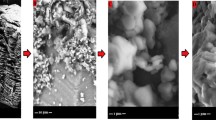Abstract
Quartz is the most stable natural solid phase of silica. It weathers extremely slowly at the Earth's surface1, and often resists weathering even after all other silicate minerals have been degraded. However, there is ample evidence from both ancient and modern environments indicating enhanced dissolution and mobility of silica under conditions that cannot easily be explained by the inorganic controls of quartz solubility2. Increased solubility of quartz has been observed particularly in soils rich in organic material; however, no direct link between dissolved organic carbon and dissolved silica has been identified3. Here we present evidence for an increase in the solubility of quartz in a natural water brought about by dissolved organic compounds. These compounds were produced by the biodegradation of petroleum, and consist largely of a complex mixture of organic acids. We propose that silica is being complexed and mobilized by these organic acids in waters having close to neutral pH.
Similar content being viewed by others
References
Iler, R. K. Chemistry of Silica (Wiley-Interscience, New York, 1979).
Blatt, H., Middleton, G. & Murrey, R. Origin of Sedimentary Rocks (Prentice-Hall, Englewood Cliffs, New Jersey, 1972).
Chesworth, W. & Macias-Vasquez, F. Am. J. Sci. 285, 128–146 (1985).
Van Lier, J. A., De Bruyn, P. L. & Overbeek, J. Th. G. J. phys. Chem. 64, 1675–1682 (1960).
Fournier, R. V. & Potter, R. W. Geochim. cosmochim. Acta 10, 1969–1973 (1982).
Livingston, D. A. Prov. Pap. U.S. geol. Surv. 440-G (1963).
Chou, L. & Wollast, R. Am. J. Sci. 285, 969–993 (1985).
Rimstidt, F. D. & Barnes, H. L. Geochim. cosmochim. Acta 44, 1683–1699 (1980).
Ingri, N. in Biochemistry of Silicon and Related Problems (eds Bendz, G. & Lindqvist, I.) 3–52 (Plenum, New York, 1977).
Iler, R. K. in Biochemistry of Silicon and Related Problems (eds Bendz, G. & Lindqvist, I.) 53–75 (Plenum, New York, 1977).
Hult, M. F. U.S. geol. Surv. Water-Res. Inv. Rep. 84-4188 (1984).
Folk, R. L. J. sed. Petrology 25, 297–301 (1955).
Myshlyaeva, L. V. & Krasnoshchekov, V. V. Analytical Chemistry of Silicon (Wiley, New York, 1974).
Baedecker, M. J. 2nd Toxic Waste Tech. Meeting, Cape Cod, October 1985 (US Geol. Surv., in the press).
Wood, W. W. in Techniques of Water-Resources Investigations of the U.S. Geological Survey. Book 1, Chap. D2 (US Government Printing Office, Washington DC, 1981).
Chang, F., Hult, M., Hoben, N. & Brand, D. 2nd Toxic Waste Tech. Meeting Cape Cod, October 1985 (US Geol. Surv., in the press).
Krinsley, D. H. & Doornkamp, J. C. Atlas of Quartz Sand Surface Textures (Cambridge University Press, 1973).
Norendova, I. K., Arkhangel'skaya, R. A. & Tarrasova, T. G. Geokhimiya 3, 408–414 (1978).
Atlas, R. M. Petroleum Microbiology (MacMillan, New York, 1984).
Liu, D. L., Dutka, B. J. J. WPCF 45, 232–239 (1973).
Surdam, R. C., Boese, S. W. & Crossey, L. J. in Clastic Diagenesis (eds McDonald, D. A., Surdam, R. C.) 127–150 (American Association of Petroleum Geologists, Tulsa, 1984).
Zutic, V. & Stumm, W. Geochim. cosmochim. Acta 48, 1493–1503 (1984).
Huang, W. H. & Keller, W. D. Am. Miner. 55, 2076–2094 (1970).
Author information
Authors and Affiliations
Rights and permissions
About this article
Cite this article
Bennett, P., Siegel, D. Increased solubility of quartz in water due to complexing by organic compounds. Nature 326, 684–686 (1987). https://doi.org/10.1038/326684a0
Received:
Accepted:
Issue Date:
DOI: https://doi.org/10.1038/326684a0
- Springer Nature Limited
This article is cited by
-
Chemo-mechanical Alteration of Silicate-Rich Shale Rock after Exposure to CO2-Rich Brine at High Temperature and Pressure
Rock Mechanics and Rock Engineering (2023)
-
Relations of Uranium Enrichment and Metal Sulfides within the Shuanglong Uranium Deposit, Southern Ordos Basin
Journal of Earth Science (2022)
-
Distribution of benthic foraminiferal assemblages in the transitional environment of the Djerba lagoon (Tunisia)
Swiss Journal of Geosciences (2018)
-
Review: Natural tracers in fractured hard-rock aquifers in the Austrian part of the Eastern Alps—previous approaches and future perspectives for hydrogeology in mountain regions
Hydrogeology Journal (2016)
-
Volcaniclastic fan facies and reservoir characteristics: a case study of Guantao Formation in the No. 1 and No. 2 structures in the Nanpu Sag, Bohai Bay Basin, East China
Arabian Journal of Geosciences (2016)





